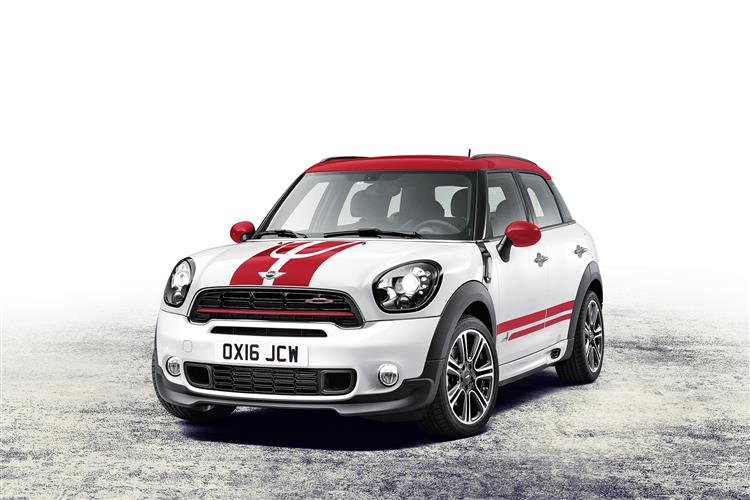This is a sample, showing 30 seconds of each section.
BIG COUNTRY (some text hidden) SECTIONED_new_minijohncooperworkscountryman_2013
By Jonathan Crouch
Introductionword count: 59
The first generation version of MINI's five-door MINI Countryman might not seem like the obvious choice for hot hatch John Cooper Works treatment but the result might just surprise you. No other MK1 model MINI Countryman offered more power, enough to skittle you to sixty two mph in just 7.0s, helped by prodigious all-wheel traction. It's quite a package.
Modelsword count: 5
5dr SUV (1.6 petrol JCW])
Historyword count: 298
Indulge us here. You might think this is a monstrous heresy, but we'd like to draw a comparison. Remember the awesome Audi Quattro, the original 20v model back in the Eighties? If you do, then you'll recall something of an automotive legend. With four-wheel drive punch for traction in all weathers, a turbocharged engine capable of 217bhp, space inside for four to five people and the ability to leap to 60mph in less than seven seconds, it was quite a machine. Weird to think then, that all those qualities that once made the Audi such a supercar slayer were also back in 2012 also made available in, of all things, a MINI. This one - the John Cooper Works Countryman. On first acquaintance, the very name seems contradictory. 'John Cooper Works', after all, is a brand that gives fashionable little MINIs a frantic feel. But there's nothing very little - and you'd think, nothing especially frantic - about the company's Countryman model, a beefy five-door crossover-style design focused on families. Not the kind of thing you'd naturally want to be flinging about the lanes. Yet this is exactly what this car was designed to do. It was the very first John Cooper Works MINI to get four wheel drive and back in 2012, no other JCW model in the range was firmer or more powerful. Yet it still manages to offer standards of fuel economy, safety and space that would shock not only original Quattro customers but also most MINI buyers. This then, was a crossover with a point to prove. It was originally launched with a 1.6-litre engine tuned to 211bhp, a unit boosted to 218bhp in 2015. It sold until 2017 when a second generation Countryman JCW model was introduced powered by a 2.0-litre turbo engine.
What You Getword count: 510
This is certainly no Countryman for old men. In fact, it's actually quite a stylish thing in this guise, which might surprise those who may have dismissed more mundane versions of this model as being rather frumpy. In JCW trim, the muscular nose gets a big, wide grille, huge air intakes and a beefy spoiler, into which are set piercing front foglights. A bodykit completes a ground-hugging appearance emphasised by a 10mm lower ride height and offset by a dynamic set of 18” or 19” alloys. In true MINI style, there's a contrast paint finish for the roof and exterior mirror caps which can be either white, black or a red exclusive to the John Cooper Works models. You'll also find the same colours used for optional body stripes that many original owners found it hard to resist. It all rather disguises the fact that like any Countryman, this one is actually a relatively large car - and one that would appear positively enormous were you to park it next to a 1960s original Mini. The payoff comes inside, where a stretched floorplan means that, unlike the MK1 Clubman estate from this era, this really is a MINI able to offer two proper rear doors and a back seat that two fully-sized adults can get comfortable in. Most original buyers went for two individual rear seats, but there was also the option of a rear bench, theoretically big enough for three, provided that the middle occupant is a fairly small child. Models equipped with the bench don't get the novel centre rail that's fitted to cars featuring two individual rear seats. Onto this rail, all manner of (mostly optional) items could be clipped. Most original owners wanted these to include things like cupholders and a sunglasses-holder but buyers who made free with the options list ended up clip on everything from iPhone chargers to dog bowls. The individual rear seats can recline for greater comfort on longer journeys and slide backwards and forwards so that you can have a large boot or plenty of legroom. Sadly, there's not quite enough space for you to have both at the same time. Still, the VW Golf-rivalling 350-450-litres you do get is double that of an ordinary MINI, even if the seats-folded total of 1170-litres isn't quite as class-competitive. There's a bit of a step up in the boot floor with the seats down too. Up-front, all the expected MINI design cues are present and correct. With the exception of the rather awkward-to-use aircraft-style handbrake, owners familiar with the brand's smaller models will feel right at home. There's the usual over-sized speedometer, with an high definition colour screen at its centre that displays the clever MINI Connected system, capable of replicating everything on your iPhone for easy reference as you drive. There aren't too many interior concessions to this car's status as one of the most expensive MINI models ever made, but the cockpit design is neatly set off by Piano Black interior detailing and an anthracite-coloured roof liner. What To Look For
To see the full road test text contact us on 0330 0020 227
Pictures (high res disabled)

.jpg)
|
.jpg)
|
Scoring (subset of scores)
Category:
| Performance | |
| Handling | |
| Comfort | |
| Space | |
| Styling, Build, Value, Equipment, Depreciation, Handling, Insurance and Total scores are available with our full data feed. | |



